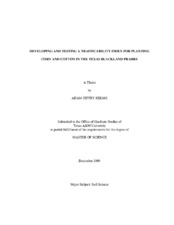| dc.description.abstract | The Texas Blackland Prairie is one of the most productive agricultural regions in
Texas. This region provides a long growing season coupled with soils that have a high
water holding capacity. However, the soils also provide significant challenges to
producers because the high water holding capacity is a product of a high clay percentage.
This research was aimed to develop and test an expert-based trafficabililty index, based
upon soil moisture, for planting cotton (Gossypium hirsutum L.) and corn (Zea mays L.)
on the Texas Blackland Prairie. Testing the index focused on quantify the potential
effect of high soil moisture at planting on seed furrow sidewall compaction and
associated plant growth response. Once the trafficability index was developed, three
workable soil moisture regimes were recreated in no-tillage and conventional tillage
plots at the Stiles Farm Foundation in Thrall, Texas. The index nomenclature included:
"Dry-Workable", "Optimal" and "Wet-Workable". After planting corn and cotton into
conventional and no tillage plots, 0.45 x 0.20 x 0.15 m intact soil blocks were removed
from each plot and kept in a controlled environment. At 28 days, each block was
destructively harvested to quantify plant root and shoot growth responses. Each of the three soil moisture indexes was replicated thrice per crop, and the whole experiment was
replicated twice in time, n = 48 blocks.
The trafficability index was created using three producer experts, and over 10
interviews to collect a range in soil moisture samples. From "Wet Workable" to "Dry
Workable", the gravimetric soil moistures were 0.17, 0.22, and 0.26 g g-1. For corn and
cotton, a positive relationship between plant growth factors and planting at soil moisture
existed. Plants planted at the highest soil moisture emerged faster and developed more
root and shoot biomass than those planted at the lowest soil moisture. No evidence of a
detrimental plant response because of seed furrow, sidewall compaction from planting at
too high a soil moisture content could be quantified. Furthermore, the cotton plants in
no-tillage performed better than in conventional tillage, but corn performed better in
conventional tillage. Because the results showed an advantage to plant growth by
planting in the "Wet Workable" index, the tillage practice that allows the producer to
enter the field with a planter at higher moisture contents appears to have an advantage. | en |


